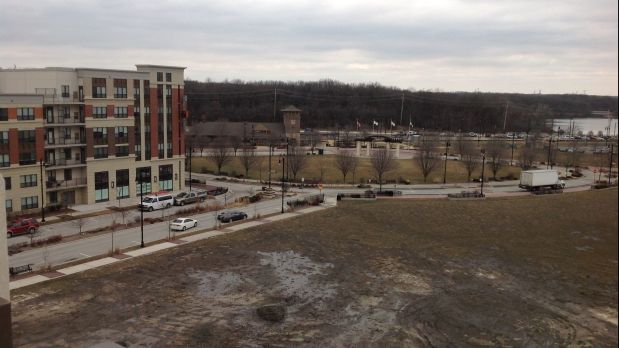The development of Orland Park’s long-planned downtown would get a big lift from an economic development tool used throughout the south and southwest suburbs, and plans for which are being advanced by village officials.
It involves creating a fresh tax increment financing district focused on what is generally referred to as the Main Street Triangle, northwest of La Grange Road and 143rd Street.
The village owns seven properties spread over 9 acres, and has been working for more than two years with an Orland Park-based firm Edwards Realty, which is proposing more than 140,000 square feet of commercial and office space and a larger park in the center of the site.
The development would be situated around the Ninety7Fifty on the Park apartments, University of Chicago Medicine Center for Advanced Care, a parking garage and the 143rd Street Metra station.
Plans for a new tax increment financing district in Orland Park’s proposed downtown development are advancing. (Mike Nolan / Daily Southtown)
“It’s an economic development tool that uses its own money to fund it,” Mayor Keith Pekau said of the proposed TIF district at a public hearing Tuesday.
The next steps are for the necessary ordinances to be drawn up and approved by the Village Board, expected to come later this month, then final approval of the redevelopment plan with Edwards expected at Oct. 7.
Edwards plans, pending further approval, to break ground by late October, according to the village.
In a TIF district, property taxes for all government bodies are frozen at levels at the time the TIF is created and any increase due to higher property values, the increment, is used to pay for improvements or incentives. TIF districts typically expire after 23 years but can be extended to up to 35 years.
The triangle’s TIF first tax year was 2003, and the thinking by village officials is by the time much of the development is completed, the TIF will have expired or have just a few years of life left.
The equalized assessed value of land available for development is $158,000 and that is projected to increase to $35 million by tax year 2043, according to SB Friedman Development Advisors, hired by Orland Park for the TIF evaluation.
Edwards and the village anticipate total redevelopment costs will be in the neighborhood of $87 million, and the developer could recoup up to $70 million through the TIF and other funding sources.
Plans by Edwards propose reconfiguring Crescent Park Circle, which wraps around Crescent Park, and leave Jefferson Avenue north of 142nd closed to vehicles and serve as a pedestrian strip.
Plans from Edwards propose 37,000 square feet of mixed office space, 84,000 square feet of retail and other commercial and 26,000 square feet of entertainment. No residential development is planned.
An expansion of Crescent Park, to be renamed Heroes Park, is included, and what is now a stormwater detention pond in the northeast corner of the triangle would be enhanced with fountains.
It is anticipated the increased growth in property tax revenue set aside will be sufficient to pay most of the development costs, but there are also options planned and discussed to help foot the bill.
Some of the money to pay for the project would come from a 1 percentage point increase on the sales and hotel tax imposed on businesses within the district, with the tax in place for up to 23 years.
That would be on top of the village’s home rule sales tax of 1.25%.
Other taxing bodies, such as school districts, don’t see increased property tax revenue from any development until after the TIF expires, and don’t have a share of any community’s sales tax money.
A special service area would be created in the redevelopment area and use property tax money from a special levy to pay for things such as road maintenance, stormwater infrastructure, maintenance of common space and park areas and seasonal decorations for common areas.
Orland Park is also mulling possible bond sales, with money to repay them coming from the TIF, to help finance plans.
Under the redevelopment plans, Edwards would be available for reimbursement of TIF-eligible costs, including land purchase, costs of marketing sites to potential developers and costs of public works, such as streets and sidewalks.
Up to $10 million could flow back to Edwards for costs such as relocating utilities and development of Heroes Park.
Buying and preparing parcels for development could be reimbursed up to $27 million, and a bit more than $39 million would be available for public improvements.
It is estimated development would be completed by the end of 2048, and it is assumed Edwards would buy from the village then sell off individual lots or groups of lots to developers.
A traffic study submitted this summer indicated streets inside the triangle would be able to handle traffic, and a total of 1,456 parking spaces would be available, although the goal is to encourage walking through most of the development.
That parking figure includes the existing 574-space elevated parking garage and Metra parking.
Parking in the Metra lots is free on weekends and after 3 p.m. on weekdays, and while some of the spaces in the garage are reserved for the hospital clinic, that is largely available in the evenings, according to the village.
Multiple phases would take place, and the Village Board could approve individual phases without the need for more Plan Commission review, according to the development proposal.
Orland Park officials first gave the OK to a conceptual redevelopment plan for the village-owned property in May 2022.





